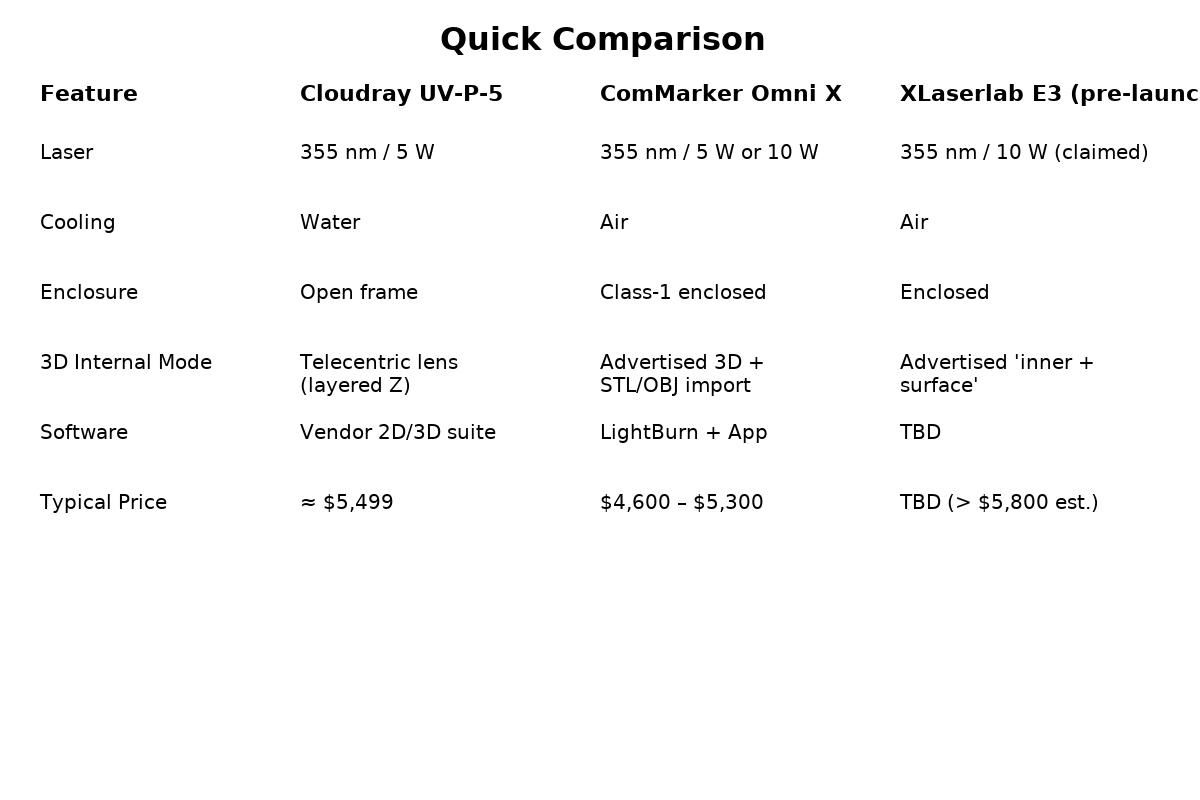Comparing Three UV Laser Contenders: Cloudray, ComMarker, and XLaserlab
GK
If you’ve ever seen a UV laser magically engraving inside a block of crystal and thought, “That’s witchcraft,” you’re not wrong — it’s basically controlled micro-fracturing with a lot of marketing polish on top.
I’ve been digging into three popular contenders that all promise to pull off this trick: Cloudray, ComMarker, and XLaserlab. Each claims you can engrave on the surface like a normal human and inside glass like a wizard. The catch? They all get there a little differently.
Before we dive in, remember — this is research, not a hands-on test. I’m gathering facts, claims, and a bit of experience from too many years watching companies stretch the definition of “industrial-grade.”
If any of this starts sounding like a foreign language, scroll to the Definitions section at the end. That’s where I decode the buzzwords like telecentric lens, M², and galvo — which sound high-tech but usually mean “we focused the beam properly.”
Cloudray UV-P-5:
Dual-Lens Practicality and a Little Bit of DIY Charm
Cloudray sits in that middle ground between hobby and industrial. Their UV-P-5 is a 5-watt, 355 nm laser with two lenses:
one for surface engraving, and one “telecentric” lens for shooting inside the glass.
It’s open-frame — which means you’ll want to add your own safety enclosure unless you like the smell of ozone and the thrill of retinal risk.
What’s to like:
Solid beam quality and build for the price
Comes with a dedicated inner-engraving lens
Great spare-parts availability (they literally sell everything down to the screws)
Around $5,499, which is pretty reasonable for UV territory
What to watch for:
The focusing system is a bit mysterious — is it “dynamic” or just “move the Z-axis and hope”?
Software looks functional but not exactly friendly
Verdict: A solid mid-range machine for tinkerers and technically curious types who don’t mind getting their hands dirty.
ComMarker Omni X:
The Plug-and-Play People’s Laser
ComMarker’s Omni X wants to make UV engraving look easy — and to be fair, it mostly succeeds. It’s a Class 1 enclosed system with autofocus, air cooling, and comes in 5 W or 10 W flavors. It even talks to LightBurn, which is like saying “we speak fluent maker.”
It claims 3D internal engraving, and it actually lists STL/OBJ file import — a big deal if you’re converting real 3D models into point clouds for glass engraving.
What’s to like:
Safe, enclosed cabinet with built-in autofocus
Dual power options and LightBurn integration
Price hovers between $4,600 and $5,300
Good looking, ready to work right out of the box
What to watch for:
We still don’t know how it performs deep inside glass — the marketing photos look good, but I want to see dots, not dust.
Less flexible for swapping optics or tinkering
Verdict: If you want a UV laser that feels like a finished appliance and not a science project, this is your entry ticket.
XLaserlab E3:
The Ambitious Newcomer with Something to Prove
The E3 is currently in pre-launch, but the early specs sound impressive: 10 W UV, AI-assisted autofocus, camera alignment, and bragging rights about 0.005 mm spot size.
If it actually ships with those specs intact, it could shake things up — but right now, we’re all just waiting for the curtain to lift.
What’s to like:
Ambitious optical design and feature set
Promised higher power and smart alignment tools
What to watch for:
Still in the “deposit now, details later” phase
No confirmed users, test results, or final pricing
Verdict: Potentially excellent… or just excellent marketing. Either way, it’s one to watch.

Pros and Cons in Plain English
Cloudray UV-P-5
✅ Well-built, flexible, lots of parts and community support
❌ Requires safety upgrades and software patience
ComMarker Omni X
✅ Safe, slick, and easy to use — ready for shops and schools
❌ Less customizable; “3D” mode still waiting for proof of depth
XLaserlab E3
✅ Promising high-end specs and innovation
❌ Pre-launch uncertainty — might be a star, might be a myth
Definitions for Normal Humans
Telecentric Lens – Keeps the laser beam straight and uniform across the field, great for surfaces and shallow internal marks.
Dynamic-Focus (3D Galvo) – Actively shifts focus while engraving to place dots at different depths — the trick behind true “inside the crystal” engraving.
M² (Beam Quality) – How perfectly the beam focuses. Closer to 1 = cleaner, smaller dots.
STL/OBJ – 3D file types that tell the laser where to put millions of microscopic points.
Galvo – The lightning-fast mirror system steering the beam across X and Y.
Final Thoughts
All three of these machines make the cut in their price range.
They’re genuine UV systems, not re-badged toys, and they show how quickly the “serious” end of the market is becoming accessible.
Each has a different personality — Cloudray’s the engineer’s playground, ComMarker’s the showroom performer, and XLaserlab’s the mysterious new kid who might just ace the test.
As always in this trade:
only you will know the right tool for your job.